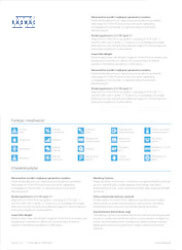PUE HY10 Weighing Terminal

Measurement data

Construction

Flexible support for multiple weighing platforms

Multifunctional Software

Communication Interfaces
Wi-Fi® is a registered trademark of Wi-Fi Alliance®.
PUE HY10 Weighing Terminal





| OIML Class | II or III |
| Maximum quantity of verification units | 6000 e |
| Minimum volatge per verification unit | 0.4 µV |
| Maximum voltage per verification unit | 3.25 µV |
| Minimum load cell impedance | 50 Ω |
| Maximum load cell impedance | 1200 Ω |
| Load cell excitation voltage | 5V DC |
| Maximum increase of signal | 19.5 mV |
| Connection of load cells | 4 or 6 wires + shield |
| Display | 10.1″ graphic colour touchscreen |
| Device dimensions W x D x H | 357×275×120 mm |
| Packaging dimensions W x D x H | 420×350×230 mm |
| Net weight | 5.7 kg |
| Gross weight | 6.5 kg |
| Protection class | IP 66 / 67 / 69 |
| Touch panel | capacitive |
| Keypad | touch screen |
| Housing | Stainless steel |
| Communication interface | 2×RS232, 2×USB-A, Ethernet, 4 IN / 4 OUT (digital) |
| Optional interfaces | module Wi-Fi® 802.11 b/g/n, module Profibus (DP SLAVE), module RS485, module PROFINET (RJ45), analog output module (4-20mA, 0-20mA, 0-10V) , 12IN / 12OUT (IN – 5-24 VDC, OUT – max 30 VDC, 0.5 ADC) |
| Operating temperature | -10 – +40 °C |
| Relative humidity | 10% – 85% RH no condensation |
| Operating system | Linux |
| Processor | quad-core 64-bit Cortex-A53 1.2 GHz |
| Memory | RAM 1GB LPDDR2 |
| Data memory | 16 GB (micro SD) |
| Max number of platforms | 4 |


